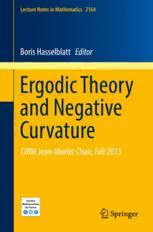
Ergodic Theory and Negative Curvature: CIRM Jean-Morlet Chair, Fall 2013 PDF
Preview Ergodic Theory and Negative Curvature: CIRM Jean-Morlet Chair, Fall 2013
Lecture Notes in Mathematics 2164 Boris Hasselblatt Editor Ergodic Theory and Negative Curvature CIRM Jean-Morlet Chair, Fall 2013 Lecture Notes in Mathematics 2164 Editors-in-Chief: Jean-MichelMorel,Cachan BernardTeissier,Paris AdvisoryBoard: MichelBrion,Grenoble CamilloDeLellis,Zurich AlessioFigalli,Zurich DavarKhoshnevisan,SaltLakeCity IoannisKontoyiannis,Athens GáborLugosi,Barcelona MarkPodolskij,Aarhus SylviaSerfaty,NewYork AnnaWienhard,Heidelberg Moreinformationaboutthisseriesathttp://www.springer.com/series/304 Boris Hasselblatt Editor Ergodic Theory and Negative Curvature CIRM Jean-Morlet Chair, Fall 2013 123 Editor BorisHasselblatt DepartmentofMathematics TuftsUniversity Medford,Massachusetts USA ISSN0075-8434 ISSN1617-9692 (electronic) LectureNotesinMathematics ISBN978-3-319-43058-4 ISBN978-3-319-43059-1 (eBook) DOI10.1007/978-3-319-43059-1 LibraryofCongressControlNumber:2017953454 MathematicsSubjectClassification(2010):37C40,37D40 SpringerChamHeidelbergNewYorkDordrechtLondon ©SpringerInternationalPublishingSwitzerland2017 AcopublicationwiththeSociétédeMathématiquedeFrance(SMF)Soldanddistributedtoitsmembers by the SMF, Institut Henri Poincaré, 11 rue Pierre et Marie Curie, 75231 Paris Cedex 05, France; http://smf.emath.fr ISBNSMF:978-2-85629-860-2 Thisworkissubjecttocopyright.AllrightsarereservedbythePublisher,whetherthewholeorpartof thematerialisconcerned,specificallytherightsoftranslation,reprinting,reuseofillustrations,recitation, broadcasting,reproductiononmicrofilmsorinanyotherphysicalway,andtransmissionorinformation storageandretrieval,electronicadaptation,computersoftware,orbysimilarordissimilarmethodology nowknownorhereafterdeveloped. Theuseofgeneraldescriptivenames,registerednames,trademarks,servicemarks,etc.inthispublication doesnotimply,evenintheabsenceofaspecificstatement,thatsuchnamesareexemptfromtherelevant protectivelawsandregulationsandthereforefreeforgeneraluse. Thepublisher,theauthorsandtheeditorsaresafetoassumethattheadviceandinformationinthisbook arebelievedtobetrueandaccurateatthedateofpublication.Neitherthepublishernortheauthorsor theeditorsgiveawarranty,expressorimplied,withrespecttothematerialcontainedhereinorforany errorsoromissionsthatmayhavebeenmade.Thepublisherremainsneutralwithregardtojurisdictional claimsinpublishedmapsandinstitutionalaffiliations. Printedonacid-freepaper ThisSpringerimprintispublishedbySpringerNature TheregisteredcompanyisSpringerInternationalPublishingAG Theregisteredcompanyaddressis:Gewerbestrasse11,6330Cham,Switzerland Preface Thisvolumeconsistsofnotesfromminicoursesgiveninworkshopsheldunderthe auspicesoftheJean-MorletChairatCIRMin2013and2014andwithsubstantial coresupportandfundingbyCIRM. Mostofthesecoursesweregivenduringtheworkshop“YoungMathematicians in Dynamical Systems” organized by the GDR Platon under the direction of Françoise Dal’Bo of Université Rennes 1; her co-organizers were Louis Funar (Université Grenoble 1), Boris Hasselblatt (Tufts University, CIRM, and Aix- MarseilleUniversité),andBarbaraSchapira(UniversitédePicardieJulesVerne).1 The event was supported by several ANRs such as GEODE, directed by Barbara Schapira, and by the LABEX Archimede. The centerpieces were minicourses by Keith Burns (Northwestern University), Carlos Matheus (Instituto Nacional de Matemática Pura e Aplicada in Brazil and Université Paris 13), and Boris Hasselblatt.ThescientificfocuswastheergodicityoftheWeil–Peterssongeodesic flow on Teichmüller space. The course by Burns presented geodesic flows and methodsforprovingtheirergodicity,thatbyMatheusintroducedTeichmüllerspace and the Weil–Petersson metric, and that by Hasselblatt provided an introduction to hyperbolic dynamical systems and ergodic theory. Barbara Schapira presented in a unified way the classical dynamical and ergodic properties of the horocy- cle flow in the Spring 2014 School on Geometry and Dynamics,2 which was organizedbyNicolasBedaride(Aix-MarseilleUniversité),AlexanderBufetov(Aix- Marseille Université), Moon Duchin (Tufts University), Boris Hasselblatt, Pascal Hubert (Aix-Marseille Université), and Federico Rodriguez Hertz (Pennsylvania State University) with the scientific committee consisting of Giovanni Forni (the University of Maryland), Boris Hasselblatt, Howard Masur (the University of IllinoisatChicago andUniversityof Chicago),and GrigoriOlshanski(Dobrushin 1The participant list is at http://www.cirm-math.fr/Archives/?EX=liste_participants&annee= 2013&id_renc=1097&num_semaine=0. 2The participant list is at http://www.cirm-math.fr/Archives/?EX=liste_participants&annee= 2014&id_renc=1129&num_semaine=0. v vi Preface Mathematics Laboratory at the Institute for Information Transmission Problems of the Russian Academyof Sciences, the IndependentUniversityof Moscow,and the NationalResearch University–HigherSchoolofEconomics).Itwas supported amongothersbytheNationalScienceFoundation,A*Midex,andtheGDRPlaton. Thecontentsofthisvolumeareasfollows.Itbeginswithfoundationalmaterial: an introduction to hyperbolic dynamics and ergodic theory (plus a translation of Hadamard’sproofofthestable-manifoldtheorem)byBorisHasselblattfollowedby onetothedynamicsofgeodesicandhorocyclicflowsbyBarbaraSchapira. The nextthree chapterscover the motivating mathematicsfor the workshopas follows:AdetailedsummaryoftheBurns–Masur–Wilkinsonpaper“Ergodicityof theWeil–PeterssonGeodesicFlow”laysouttheagendaandcoreideas.Atextbased onthelecturesbyBurns(“ErgodicityofGeodesicFlowsonIncompleteNegatively CurvedManifolds”)thenprovidesalltheinsightsintotheergodicityproof.Finally, thelecturenotesbyMatheus(“TheDynamicsoftheWeil–PeterssonFlow”)provide comprehensive background on the Teichmüller theory at the base of the whole problem. We also includeda surveyof somearithmeticapplicationsof ergodictheoryin negativecurvature,whichroundsoutthevolumebyaddinganothertopiccentered onergodicityofgeodesicflowsinnegativecurvature. Thereisnoneedtoreadthisbooksequentially.Thechaptersmakeitaseasyas possible to read any one of them independently while keeping it easy to refer to otherchaptersforanyneededcontext. TheeditorgratefullyacknowledgespartialsupportbytheCommitteeonFaculty Research Awards of Tufts University and will forever be indebted to CIRM for 6 monthsoftrulyexceptionalworkingconditions. Medford,MA,USA BorisHasselblatt April2017 Contents 1 IntroductiontoHyperbolicDynamicsandErgodicTheory ............ 1 BorisHasselblatt 2 OnIterationandAsymptoticSolutionsofDifferentialEquations byJacquesHadamard....................................................... 125 BorisHasselblatt(Translator) 3 DynamicsofGeodesicandHorocyclicFlows ............................. 129 BarbaraSchapira 4 ErgodicityoftheWeil–PeterssonGeodesicFlow......................... 157 KeithBurns,HowardMasur,andAmieWilkinson 5 ErgodicityofGeodesicFlowsonIncompleteNegativelyCurved Manifolds ..................................................................... 175 KeithBurns,HowardMasur,CarlosMatheus,andAmieWilkinson 6 TheDynamicsoftheWeil–PeterssonFlow................................ 209 CarlosMatheus 7 ASurveyofSomeArithmeticApplicationsofErgodicTheory inNegativeCurvature....................................................... 293 JouniParkkonenandFrédéricPaulin vii Chapter 1 Introduction to Hyperbolic Dynamics and Ergodic Theory BorisHasselblatt 1.1 Introduction 1.1.1 GuidedTour These are notes based on a minicourses given at the Centre International de RencontresMathématiques,MarseilleinNovember2013,attheUniversityofTokyo inJune2014,andthe2015HoustonSummerSchoolonDynamicalSystems.They owe much to these experiences,and I would like to thank the organizersof these schools for their invitation and hospitality as well as the participants for their engagementandtheirattentivecommentsonthesenotes. Whiletherearemanygoodintroductionstohyperbolicdynamicalsystems,1two aspectsofthisoneareofinterest.Ononehand,weimplementanunderappreciated approachduetoBowen,AnosovandKatok[Bo75,Bo78,Ka81]toobtainthebasic topologicaldynamicsofuniformlyhyperbolicdynamicalsystemsfromshadowing and expansivity; this is the content of Sect.1.3.3. On the other hand, we use the Hopfargumenttoobtainmultiplemixingofhyperbolicdynamicalsystems—which meansthatwecandosowithoutanyreferencetoentropytheoryorresultsthatuse it.Thus,pages24–44canberegardedastheprincipalnoveltyofthesenotes. The lectures gave an introduction to some features of the topological and measurable dynamics of hyperbolic systems, mainly in discrete time, and this is an essentially self-contained account of these basics. The first half is devoted to 1Notably[Yo95],whichinspiredSect.1.6,whereweprovetheStable/UnstableManifoldTheorem usingthePerron–Irwinmethod.Altogetherthesenotesowemuchto[Co07,KaHa95,Yo95]. B.Hasselblatt((cid:2)) DepartmentofMathematics,TuftsUniversity,Medford,MA02155,USA e-mail:[email protected] ©SpringerInternationalPublishingSwitzerland2017 1 B.Hasselblatt(ed.),ErgodicTheoryandNegativeCurvature, LectureNotesinMathematics2164,DOI10.1007/978-3-319-43059-1_1 2 B.Hasselblatt hyperbolic dynamical systems, and the second half (Sect.1.7) introduces ergodic theory. While a central point is that these subjects interact deeply, the halves are essentially independent,to the point of having some duplication(mainly between Sects.1.5and1.7).Acommonfeatureisthatentropytheoryisabsent,andanovelty isthatmultiplemixingpropertiesareobtainedwithoutit. The sections on hyperbolic dynamics are modular and can be read largely independently.That is, each part can largely be read on its own or omitted on its own.ThisismostevidentlysoforthissectionandthehistoricalsketchinSect.1.2. Theremaining“hyperbolic”sectionsarerelatedasfollows. Section 1.3 forms the centerpiece: basic and iconic features of a hyperbolic dynamicalsystemarederivedfromwhattherebyappearsastheverycorefeaturesof hyperbolicdynamics:Expansivityandshadowing.Thelatteristhatinahyperbolic systemanythingonecanimagineapproximatelyhappeningis,togoodapproxima- tion, actually happening in the system. Sections 1.3.3–1.3.6 (pages 24–31) show that the Shadowing Lemma produces the essential richness and rigidity of the orbitstructureofahyperbolicdynamicalsystem(expansivity,theAnosovClosing Lemma, specification, spectral decomposition,topologicalstability). The stronger Anosov Shadowing Theorem more easily yields structural stability and symbolic descriptions.ThiswholedevelopmentusestheContraction-MappingPrinciple(Pro- position1.6.3)butnotthetechnicalsectionsoninvariantmanifolds(Sects.1.6.4and 1.6.5),yetevenwithcompleteproofsitonlyoccupiespages24–37. Section 1.5 can also be read independently of the preceding material, though the examples in the present section will help. Based on ideas originally due to BabillotandCoudène,itshowstheHopfargumenttomaximumadvantage,which is thereforepresentedby stating explicitly what is neededfor the argumentrather thanrelyingoncontextandbackground.WhiletheHopfargumentwasdevelopedto showergodicity,weshowthatitcanbeusedeffectivelytoestablishmixingwithno addedeffort,andintherightcircumstancesmultiplemixingforevenlesseffort.A notableingredientofindependentinterestistheergodicityofthestable(orunstable) foliation,whichisrarelyfeaturedinintroductions,andwhichresultsfromasimple argument.2 Section 1.6 provides the Contraction-Mapping Principle and the Hadamard– PerronStable/UnstableManifoldTheorem.TheformerisinvokedinSect.1.3,and weillustratethemajorimportanceofthelatterinthesubjectbeyondthearguments in Sect.1.5 by using these invariant foliations to further the understanding of the topological dynamics of a hyperbolic set. We prove this using the Perron–Irwin method and provide the Hadamard method in a separate chapter in the form of Hadamard’soriginalpresentation[Ha01],translatedhereintoEnglish,presumably forthefirsttime. 2Self-containedsaveforinvokingabsolutecontinuity,whichcanbefoundin[Br02,Chap.6].
